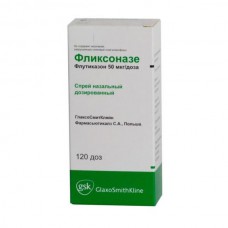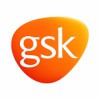Expiration date: 01/2026
the quality and form of issue:
Nasal spray dosed, 1 dose contains:
fluticasone propionate (micronized) 50 mg
excipients: dextrose (anhydrous), cellulose microcrystalline and carboxymethylcellulose phenylethyl alcohol solution of benzalkonium chloride Polysorbate 80 hydrochloric acid divorced, purified water
in bottles of yellow glass type I with a metering device 60 and 120 doses in a cardboard box 1 vial.
Description pharmaceutical form:
White, opaque suspension free of foreign particles.
Feature:
Corticosteroids for local use.
Pharmacological action:
Anti-inflammatory effect is realized in the result of the interaction of the drug with the receptor GCS. Suppresses proliferatiou fat cells, eosinophils, lymphocytes, macrophages, and neutrophils. Fluticasone propionate reduces the production of inflammatory mediators and other biologically active substances (histamine, PG, leukotrienes, cytokines) during the early and late phase allergic reactions. Restores the patient's response to bronchodilators, allowing to reduce the frequency of their use. Reduces sneezing, itchy nose, runny nose, nasal congestion, unpleasant feelings in area of the paranasal sinuses and sense of pressure around the nose and eyes. In addition, facilitates eye symptoms associated with allergic rhinitis.
Pharmacokinetics:
After intranasal fluticasone propionate (200 mcg/day) Cmax in plasma in most patients is not detected (i.e. it is less than 0.01 ng/ml). The highest Cmax — 0,017 ng/ml. the Direct absorption by nasal mucosa negligible due to the low solubility of the drug in water, resulting in a large part of the dose is eventually swallowed. From the digestive tract into the bloodstream absorbed less than 1% of the dose due to low absorption and first-pass metabolism. All this leads to the fact that the total absorption in the nasal cavity and the gastrointestinal tract (swallowed the drugs) is extremely low.
At equilibrium the concentration of plasma fluticasone propionate has a large volume of distribution (approximately 318 l). He has a fairly high ability to bind to plasma proteins (91%).
Fluticasone propionate is rapidly eliminated from plasma mainly as a result of hepatic metabolism to inactive carboxylic metabolite by the action of isoenzyme CYP3A4 of cytochrome P450. Swallowed fluticasone propionate undergoes extensive metabolism in the primary pass through the liver.
The main route of elimination is the excretion of fluticasone propionate and its metabolites in the bile.
Description pharmacological action:
Provides rapid anti-inflammatory effect on the nasal mucosa, but its anti-allergic effect is manifested through 2-4 hours after the first application.
The decrease in severity of symptoms (particularly nasal congestion) lasts for 24 h after a single injection of the spray in a dose of 200 micrograms.
Fluticasone propionate improves quality of life of patients, including physical and social activity.
When used in recommended doses, it does not possess any pronounced systemic activity and practically does not inhibit hypothalamic-pituitary-adrenal system.
Indications:
Seasonal and perennial allergic rhinitis (prevention and treatment).
Contraindications:
Hypersensitivity to fluticasone propionate or any other ingredients of drug, age up to 4 years.
Application of pregnancy and breast-feeding:
Pregnant women should refrain from using the nasal spray Flixonase, unless a doctor deems the use of this drug is needed.
Side effects:
Dryness and irritation of nose and throat, sensation of unpleasant smell and taste, headache and nosebleeds.
Possible hypersensitivity reactions, including skin rash, swelling of the face and tongue, rarely (less 1/10000) — anaphylactic reactions and bronchospasm.
Local reactions: burning sensation, nasal congestion very rare (less than 1/10000) is a perforation of the nasal septum, especially in surgical interventions in the nasal cavity in history.
Intranasal administration of 2 mg fluticasone propionate 2 times a day for 7 days had no effect on the function of the hypothalamic-pituitary-adrenal system (dose 20 times higher than therapeutic).
Drug interactions:
Due to the very low concentrations of fluticasone propionate in plasma after application of the nasal spray Flixonase clinically significant interaction is unlikely.
Ritonavir (a potent inhibitor of the coenzyme of the enzyme CYP3A4 of cytochrome P450) is able to significantly increase plasma concentrations of fluticasone propionate, resulting in dramatically reduced levels of serum cortisol, there are systemic corticosteroid side effects, including Cushing's syndrome and inhibition of the function of the adrenal glands.
Inhibitors of CYP3A4 enzyme system cytochrome P450 cause negligible (erythromycin) or minor (ketoconazole) increases in the concentrations of fluticasone propionate in plasma, which do not result in any significant increase in concentrations of serum cortisol.
Method of application and dose:
The intranasal route. Adults and children over 12 years for the prevention and treatment of allergic rhinitis the recommended dose — to 2 injection in each nasal passage 1 time per day, preferably in the morning (total dose 200 mcg/day). After achieving control of symptoms the dose can be reduced to 1 injection into each nostril 1 time a day (100 mg/day).
In some cases — on 2 injection in each nostril 2 times daily (total dose 400 mcg/day) for a short time to achieve control of symptoms, after which the dose can be reduced.
The maximum daily dose (total dose 400 mcg/day) — no more than 4 sprays in each nostril.
Elderly patients: the usual adult dose.
Children aged 4-12 years to prevent and treat seasonal allergic rhinitis — 1 injection (50 mcg) in each nostril 1 time a day. The maximum daily dose (total dose 200 mcg/day) — no more than 2 sprays in each nostril.
To achieve full therapeutic effect it is important the regular use of the drug. The drug may not produce immediate therapeutic effect, the maximum relief occurs after 3-4 days of treatment.
Inhaler use
Before use, carefully shake the bottle, take it by placing the index and middle fingers on either side of the tip, and the thumb under the bottom.
Upon first use of the drug or interruption in its use for more than 1 week you should inspect the sprayer to direct the tip of himself, to make a few clicks until the tip appears a little cloud. Next, you need to clean the nose (slightly to your nose). Close one nostril and enter the tip into the other nostril. Tilt your head forward a little, continuing to hold the vial vertically. You then begin to breathe in through the nose and continuing to inhale, to produce a single press of fingers to spray the drug. Exhale through the mouth. Repeat the procedure for the second spray in the same nostril, if necessary. Then completely repeat the procedure by entering the tip into the other nostril.
After use, wet the tip with a clean tissue or handkerchief and close it with the cap.
The sprayer should be rinsed with not less than 1 time a week. To do this, carefully remove the tip and rinse it in warm water. Shake off excess water and leave to dry in a warm place. Avoid overheating. Then carefully set the tip to its original place in the upper part of brown bottle. Put the protective cap.
If the hole of the handpiece is clogged, the tip should be removed as described above and leave for some time in warm water. Then washed under running cold water, dried and then put on the bottle. It is impossible to clean the hole of the tip with a pin or other sharp objects.
Overdose:
There is no data.
Precautions:
Care should be taken when using the drug in conjunction with strong inhibitors of CYP3A4 like ritonavir and ketoconazole as these drugs can cause increased concentrations of fluticasone propionate in plasma while the use of such dosage forms of corticosteroids such as tablets, creams, ointments, remedies for the treatment of bronchial asthma, similar nasal sprays or eye and nasal drops when there is fever (herpes), and infections of the nasal passages or sinuses (the infectious diseases of the nose require treatment, but are not a contraindication to the use of the nasal spray fluticasone propionate) after a recent nose injury or surgery in the nasal cavity, or the presence of ulceration of the mucous membrane of the nose.
Special instructions:
The drug is indicated only for intranasal administration.
If after 7 days of continuous use of the drug there is no improvement, you should consult a doctor.
Without medical supervision Flixonase nasal spray should not be applied constantly more than 6 months.
Long-term use requires regular monitoring functions of the adrenal cortex.
Full effect of nasal spray of fluticasone propionate may occur only after several days of treatment.
Care must be taken when transferring patients from systemic steroid therapy for the treatment nasal spray fluticasone propionate if there is reason to believe a violation of adrenal function.
In most patients a nasal spray fluticasone propionate eliminates the symptoms of seasonal allergic rhinitis, but in some cases, with very high concentrations in the air of summer allergens may need additional therapy.
For the relief of ophthalmic manifestations on the background of the successful treatment of seasonal allergic rhinitis may require additional therapy.


